Abstract
Fucoidan is a sulfated polysaccharide derived from brown algae that has been reported to perform multiple biological activities, including immunostimulation. In this study, we investigated whether fucoidan has beneficial effects on endotoxemia induced by LPS, a septic model in mice. The focus of this study was on survival rates and spleen function of the mice upon treatment. We found that fucoidan had prophylactic effects on the survival rate of mice with endotoxemia. Flow cytometric analysis using antibodies for subset-specific markers revealed that fucoidan profoundly reversed the depleted population of dendritic cells in mice with endotoxemia. According to Western blot analysis, the spleen cells of LPS/fucoidan-treated mice showed a higher expression of anti-apoptotic molecules compared to those of LPS-treated mice. Also, fucoidan-treated spleen cells were more responsive to mitogens. Taken together, these results demonstrate that fucoidan pre-treatment has beneficial effects on the survival rate and function of the spleen in mice with endotoxemia. This study may broaden the use of fucoidan in clinical fields, especially endotoxemia.
Go to : 
References
1. Byon YY, Kim MH, Yoo ES, Hwang KK, Jee Y, Shin T, Joo HG. Radioprotective effects of fucoidan on bone marrow cells: improvement of the cell survival and immunoreactivity. J Vet Sci. 2008; 9:359–365.

2. Frenette PS, Weiss L. Sulfated glycans induce rapid hematopoietic progenitor cell mobilization: evidence for selectin-dependent and independent mechanisms. Blood. 2000; 96:2460–2468.

3. Oomizu S, Yanase Y, Suzuki H, Kameyoshi Y, Hide M. Fucoidan prevents C epsilon germline transcription and NFkappaB p52 translocation for IgE production in B cells. Biochem Biophys Res Commun. 2006; 350:501–507.
4. Kim MH, Joo HG. Immunostimulatory effects of fucoidan on bone marrow-derived dendritic cells. Immunol Lett. 2008; 115:138–143.

5. Maruyama H, Tamauchi H, Iizuka M, Nakano T. The role of NK cells in antitumor activity of dietary fucoidan from Undaria pinnatifida sporophylls (Mekabu). Planta Med. 2006; 72:1415–1417.

6. Zen K, Liu Y, Cairo D, Parkos CA. CD11b/CD18-dependent interactions of neutrophils with intestinal epithelium are mediated by fucosylated proteoglycans. J Immunol. 2002; 169:5270–5278.

9. Tinsley KW, Grayson MH, Swanson PE, Drewry AM, Chang KC, Karl IE, Hotchkiss RS. Sepsis induces apoptosis and profound depletion of splenic interdigitating and follicular dendritic cells. J Immunol. 2003; 171:909–914.

10. Hotchkiss RS, Tinsley KW, Swanson PE, Grayson MH, Osborne DF, Wagner TH, Cobb JP, Coopersmith C, Karl IE. Depletion of dendritic cells, but not macrophages, in patients with sepsis. J Immunol. 2002; 168:2493–2500.

11. Joo HG, Goedegebuure PS, Sadanaga N, Nagoshi M, von Bernstorff W, Eberlein TJ. Expression and function of galectin-3, a beta-galactoside-binding protein in activated T lymphocytes. J Leukoc Biol. 2001; 69:555–564.
12. Kim MH, Byon YY, Ko EJ, Song JY, Yun YS, Shin T, Joo HG. Immunomodulatory activity of ginsan, a polysaccharide of Panax ginseng, on dendritic cells. Korean J Physiol Pharmacol. 2009; 13:169–173.
13. Ley K, Linnemann G, Meinen M, Stoolman LM, Gaehtgens P. Fucoidin, but not yeast polyphosphomannan PPME, inhibits leukocyte rolling in venules of the rat mesentery. Blood. 1993; 81:177–185.

14. Granert C, Raud J, Xie X, Lindquist L, Lindbom L. Inhibition of leukocyte rolling with polysaccharide fucoidin prevents pleocytosis in experimental meningitis in the rabbit. J Clin Invest. 1994; 93:929–936.

15. Thorlacius H, Vollmar B, Seyfert UT, Vestweber D, Menger MD. The polysaccharide fucoidan inhibits microvascular thrombus formation independently from P- and L-selectin function in vivo. Eur J Clin Invest. 2000; 30:804–810.
16. Hofstad T, Skaug N, Sveen K. Stimulation of B lymphocytes by lipopolysaccharides from anaerobic bacteria. Clin Infect Dis. 1993; 16 Suppl. 4:S200–202.

17. Zhang J, Qu JM, He LX. IL-12 suppression, enhanced endocytosis and up-regulation of MHC-II and CD80 in dendritic cells during experimental endotoxin tolerance. Acta Pharmacol Sin. 2009; 30:582–588.

18. Wheeler DS, Lahni PM, Denenberg AG, Poynter SE, Wong HR, Cook JA, Zingarelli B. Induction of endotoxin tolerance enhances bacterial clearance and survival in murine polymicrobial sepsis. Shock. 2008; 30:267–273.

19. Nishikawa K, Arai H, Inoue K. Scavenger receptor-mediated uptake and metabolism of lipid vesicles containing acidic phospholipids by mouse peritoneal macrophages. J Biol Chem. 1990; 265:5226–5231.

Go to : 
 | Fig. 1.The injection schedule of fucoidan and LPS. Mice were injected with PBS, 100 mg/kg fucoidan and then 10 mg/kg or 30 mg/kg LPS intraperitoneally. After all injection procedure, the mice were killed and biological samples were harvested. |
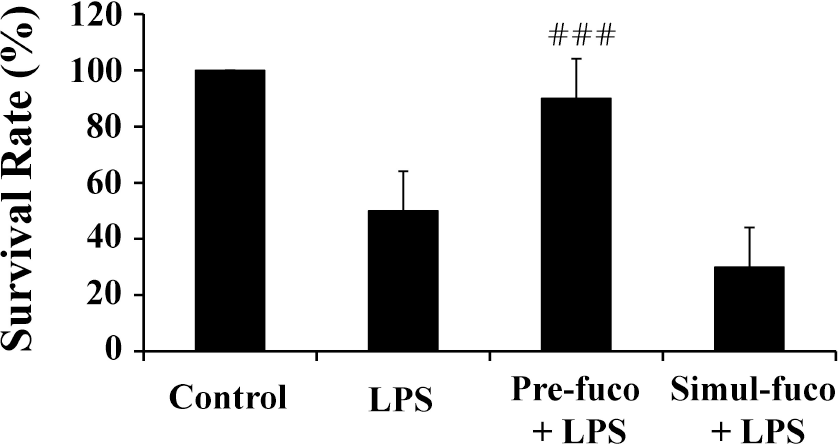 | Fig. 2.Prophylactic effect of fucoidan on the survival rate of mice with LPS-induced endotoxemia. Mice were intraperitoneally injected with 30 mg/kg LPS, a lethal dose and also with 100 mg/kg fucoidan before (Pre-) LPS injection, as described in the Methods. Other mice were injected with the same amount of LPS and fucoidan simultaneously (Simul-). The survival rate was determined 5 days after LPS injection. Each group included 5 mice. ###indicates p<0.001 compared to LPS-treated mice. |
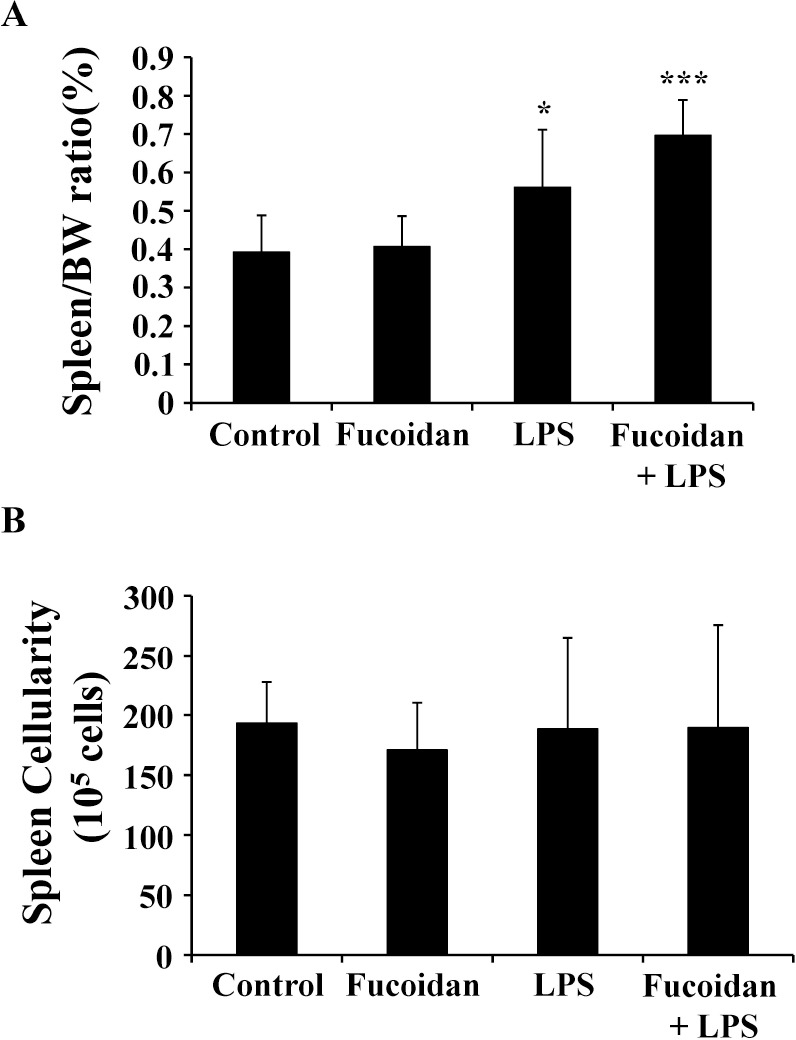 | Fig. 3.The effect of fucoidan on the spleen of mice with endotoxemia. Mice were injected with 100 mg/kg fucoidan and then 10 mg/kg LPS, a sub-lethal dose, as described in the Methods. The weight of the spleen (A) and the number of spleen cells (B) were measured. ∗, ∗∗∗p<0.05, 0.001, respectively, compared to control mice. |
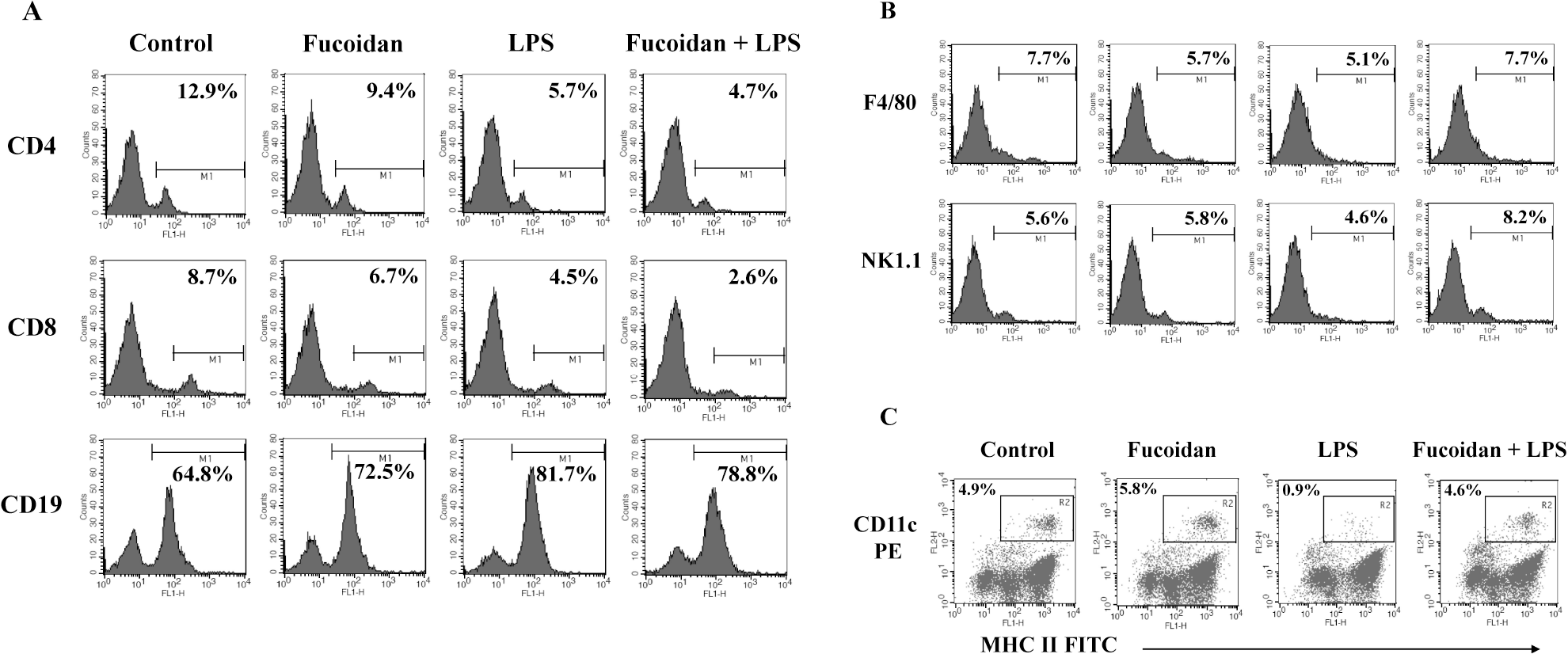 | Fig. 4.Selective recovery of DCs in spleen cells of LPS/fucoidan-treated mice. Fucoidan followed by a sub- lethal dose of LPS were administrated to mice as described in the Methods. Spleen cells were then stained for subset-specific markers (A) CD4, CD8, CD19, (B) F4/80, NK1.1, (C) CD11c and MHCII and analyzed by flow cytometry. The numbers represent the percentages of a specific subset in the spleen cells. |
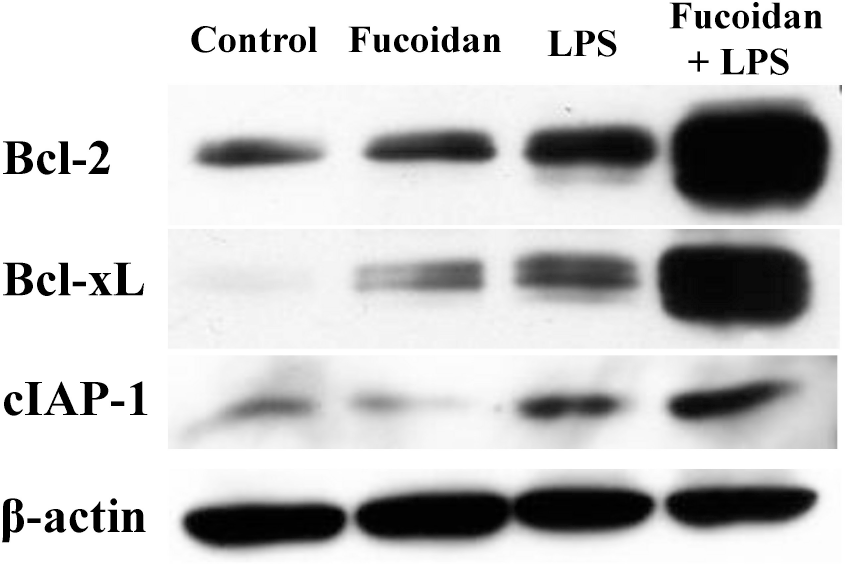 | Fig. 5.Fucoidan enhances anti-apoptotic molecules in the spleen cells of mice with LPS-induced endotoxemia. Fucoidan followed by a sub-lethal dose of LPS were administrated to mice, as described in the Methods. After harvesting the spleen cells and preparing cell lysates for Western blot analysis, the amount of protein was determined. An equal amount was loaded into each lane. Beta-actin was used as an internal control. |
 | Fig. 6.Decreased antigen uptake ability of fucoidan-treated spleen cells. Fucoidan treatment followed by a sub-lethal dose of LPS was administrated to mice as described in the Methods. Harvested spleen cells were incubated with FITC-dextran, and stained cells were analyzed by flow cytometry. |
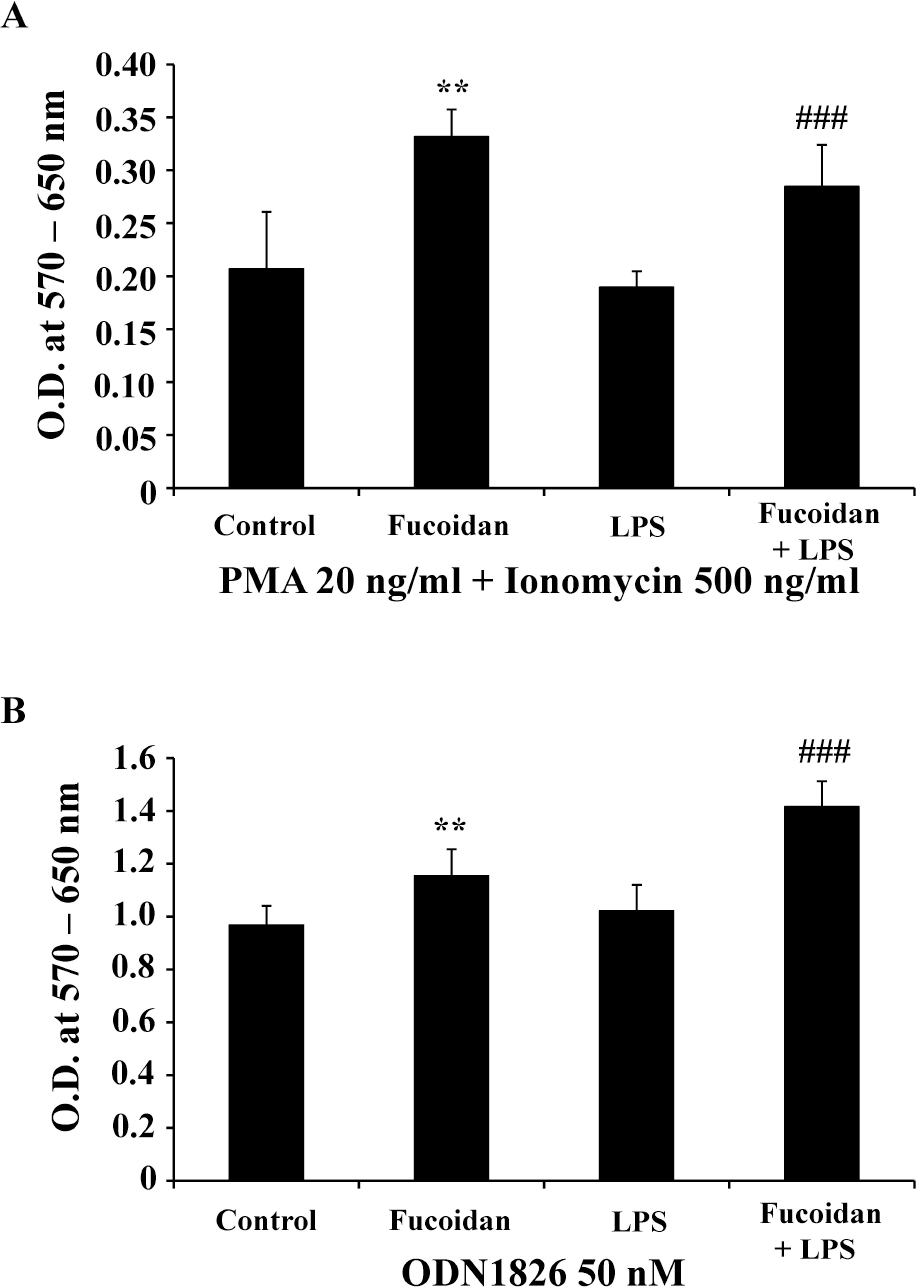 | Fig. 7.Fucoidan increases the response of spleen cells to mitogens. Fucoidan treatment followed by a sub-lethal dose of LPS was administrated to mice as described in the Methods. Harvested spleen cells were cultured at a concentration of 4×105 cells/well in 96-well culture plates. Cells were treated with 20 ng/ml PMA + 500 ng/ml ionomycin (A) and 50 nM ODN1826 (B) for 2 days. After treatments, a MTT assay was used to measure cellular activity. Data are mean±SD from six individual wells. ∗∗, ###Indicate p<0.01 and 0.001 compared to the spleen cells of controls and LPS-treated mice, respectively. |




 PDF
PDF ePub
ePub Citation
Citation Print
Print


 XML Download
XML Download